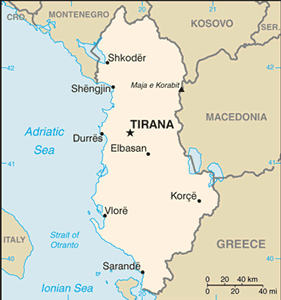The Geography of Albania
The Geography of Albania
Albanian Geography
Location: Southeastern Europe, bordering the Adriatic Sea and Ionian Sea, between Greece in the south and Montenegro and Kosovo to the north
Geographic coordinates: 41 00 N, 20 00 E
Map references: Europe
Area: total: 28,748 sq km land: 27,398 sq km water: 1,350 sq km
Area - comparative: slightly smaller than Maryland
Land boundaries: total: 717 km border countries: Greece 282 km, Macedonia 151 km, Montenegro 172 km, Kosovo 112 km
Coastline: 362 km
Maritime claims: territorial sea: 12 nm continental shelf: 200 m depth or to the depth of exploitation
Climate: mild temperate; cool, cloudy, wet winters; hot, clear, dry summers; interior is cooler and wetter
Terrain: mostly mountains and hills; small plains along coast
Elevation extremes: lowest point: Adriatic Sea 0 m highest point: Maja e Korabit (Golem Korab) 2,764 m
Natural resources: petroleum, natural gas, coal, bauxite, chromite, copper, iron ore, nickel, salt, timber, hydropower
Land use: arable land: 20.1% permanent crops: 4.21% other: 75.69% (2005)
Irrigated land: 3,530 sq km (2003)
Natural hazards: destructive earthquakes; tsunamis occur along southwestern coast; floods; drought
Environment - current issues: deforestation; soil erosion; water pollution from industrial and domestic effluents
Environment - international agreements: party to: Air Pollution, Biodiversity, Climate Change, Climate Change-Kyoto Protocol, Desertification, Endangered Species, Hazardous Wastes, Law of the Sea, Ozone Layer Protection, Wetlands signed, but not ratified: none of the selected agreements
Geography - note: strategic location along Strait of Otranto (links Adriatic Sea to Ionian Sea and Mediterranean Sea)


